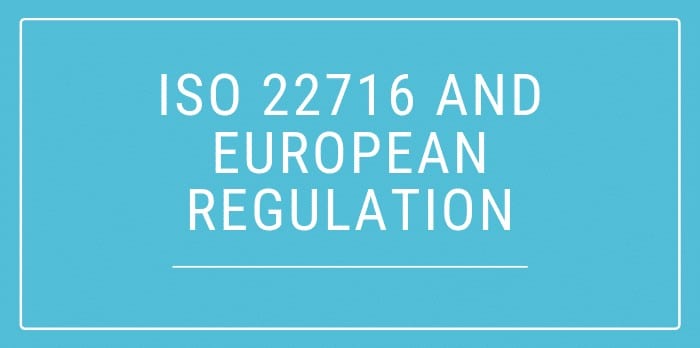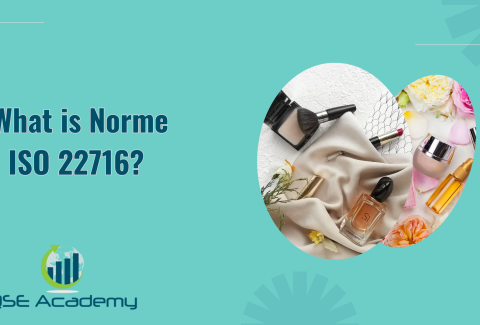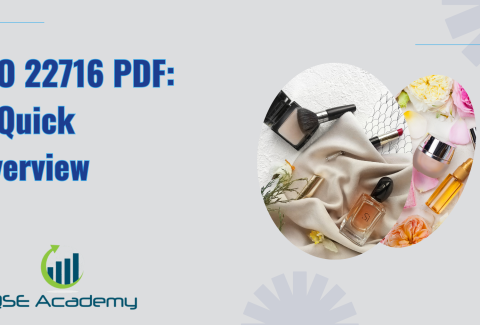ISO 22716 and European Regulations : Cosmetics GMP
ISO 22716 and European Regulations: Cosmetics GMP
If you’ve ever wondered how the cosmetics industry ensures safety and quality, let me introduce you to ISO 22716. It’s a standard that plays a critical role, especially when it comes to European cosmetic regulations. Let’s dive into what it’s all about and why it’s essential for cosmetics manufacturers.
What is ISO 22716?
In simple terms, ISO 22716 is the international standard for Good Manufacturing Practices (GMP) in the cosmetics industry. It’s like a set of golden rules that help businesses create safe, high-quality products by ensuring every part of the manufacturing process is well-controlled and documented.
From sourcing raw materials to packaging the final product, ISO 22716 outlines everything a manufacturer needs to do to ensure consistency and safety. It’s not just a guideline—it’s a practical, step-by-step framework that’s designed to help businesses meet global quality standards.
How ISO 22716 Fits into European Cosmetics GMP Regulations
When it comes to selling cosmetics in Europe, compliance with European cosmetic regulations is non-negotiable. Specifically, the EU Cosmetics Regulation (EC No. 1223/2009) sets strict rules to protect consumers. This is where ISO 22716 comes in—it provides a clear pathway for manufacturers to meet these legal requirements.
Here’s how:
- ISO 22716 for European cosmetic regulations integrates GMP into the production process, ensuring that every product is safe and traceable.
- It aligns perfectly with the EU’s focus on transparency and consumer safety, making it easier for businesses to demonstrate compliance.
Think of ISO 22716 as the bridge between your manufacturing processes and the legal expectations of the European market.
Why ISO 22716 Matters for Cosmetics GMP European Compliance
European regulations are some of the strictest in the world, and for good reason—they prioritize consumer safety. By adopting ISO 22716 for European cosmetic regulations, manufacturers can:
- Ensure their products meet the high standards expected in the EU market.
- Avoid costly mistakes like non-compliance penalties or product recalls.
- Build trust with consumers by showing a commitment to safety and quality.
For example, the standard emphasizes proper documentation, which is crucial for creating Product Information Files (PIFs)—a legal requirement in Europe. Without ISO 22716, meeting these documentation standards can become a complicated, stressful task.
In short, ISO 22716 for European cosmetic regulations isn’t just a guideline—it’s a game plan for success in the European market. By following its principles, manufacturers can ensure their products are not only compliant but also trusted and respected by customers and regulators alike. It’s about making safety and quality a priority, every step of the way.
Key Elements of ISO 22716 for European Cosmetics GMP Regulations
Now that we’ve covered what ISO 22716 is and how it aligns with European cosmetic regulations, let’s dive into the key elements that make this standard so effective. These principles ensure that every step of the manufacturing process—from sourcing ingredients to shipping finished products—meets the highest standards of safety and quality.
1. Good Manufacturing Practices Cosmetics GMP
At the heart of ISO 22716 for European cosmetic regulations is the concept of Good Manufacturing Practices (GMP). This ensures that cosmetics are manufactured in a controlled environment where risks like contamination or inconsistencies are minimized.
Here’s what GMP looks like in action:
- Maintaining a clean and hygienic facility to prevent contamination.
- Ensuring that raw materials and finished products are handled correctly.
- Establishing clear procedures for every task to ensure consistency and safety.
In short, GMP creates a strong foundation for reliable, high-quality cosmetics.
2. Documentation and Traceability
Imagine being able to trace every single ingredient in your product back to its source. That’s the level of transparency ISO 22716 for European cosmetic regulations requires. Documentation is key to meeting European compliance standards, and it includes:
- Detailed records of raw materials, including their suppliers and batch numbers.
- Logs of production processes to ensure every product is made consistently.
- Documentation of quality control checks to prove your products meet safety standards.
This level of traceability isn’t just a regulatory requirement—it’s also a valuable tool for identifying and resolving any issues quickly.
3. Facility and Equipment Standards
Your manufacturing environment plays a big role in product safety, and ISO 22716 for European cosmetic regulations emphasizes the importance of maintaining high standards. This includes:
- Designing facilities to promote smooth workflows and minimize risks.
- Ensuring equipment is clean, properly maintained, and calibrated for accuracy.
- Keeping raw materials, work-in-progress products, and finished goods stored in appropriate conditions to preserve their quality.
For example, something as simple as storing creams at the right temperature can prevent product degradation and ensure customer satisfaction.
4. Staff Training and Competency
Even with the best facilities and equipment, your team is the driving force behind compliance. ISO 22716 requires that staff involved in manufacturing, testing, and packaging are properly trained and competent in their roles.
This includes:
- Training employees on hygiene practices to prevent contamination.
- Ensuring everyone understands and follows documented procedures.
- Regularly updating training to reflect any changes in regulations or processes.
A well-trained team not only ensures compliance but also helps create a culture of quality and safety.
Why These Elements Matter
These key elements of ISO 22716 for European cosmetic regulations aren’t just about meeting legal requirements—they’re about creating products that consumers can trust. From preventing contamination to ensuring consistent quality, each principle works together to protect both manufacturers and customers.
By focusing on GMP, documentation, facilities, and staff training, you’re building a solid foundation for compliance and success in the European cosmetics market. It’s a win-win for everyone involved!
Benefits of ISO 22716 for European Compliance
By now, you’ve probably noticed how important ISO 22716 for European cosmetic regulations is for ensuring safety and quality. But what exactly are the benefits for manufacturers who adopt this standard? Spoiler alert: there are plenty! From meeting legal requirements to boosting customer trust, ISO 22716 offers significant advantages that go beyond simple compliance.
1. Ensuring Market Access
If you want to sell your cosmetics in the European Union, compliance with ISO 22716 for European cosmetic regulations is almost essential. European regulations are among the strictest in the world, and adopting ISO 22716 helps you meet these standards effortlessly.
Think of it as your ticket to the European market. By aligning your manufacturing practices with ISO 22716, you can:
- Simplify the process of gaining regulatory approval.
- Avoid costly delays caused by non-compliance issues.
- Expand your brand’s reach into one of the world’s largest cosmetics markets.
For manufacturers eyeing global expansion, this is a game-changer.
2. Building Consumer Trust
In today’s beauty industry, trust is everything. Customers want to know that the products they’re using are safe, effective, and made with care. When your brand complies with ISO 22716 for European cosmetic regulations, it sends a strong message: you prioritize quality and safety at every step.
This trust translates into:
- Increased customer loyalty as people feel confident in your brand.
- Positive reviews and word-of-mouth recommendations.
- A reputation for excellence that sets you apart from competitors.
3. Enhancing Product Quality
One of the most significant benefits of ISO 22716 is its focus on improving product quality. By implementing its guidelines, you’re creating a system that ensures every batch of cosmetics meets the same high standards.
How does this work?
- Rigorous quality control measures catch inconsistencies before they become a problem.
- Proper documentation ensures every step of production is traceable and transparent.
- Continuous monitoring helps you refine processes and improve efficiency over time.
The result? High-quality products that consumers can rely on, every single time.
4. Reducing Risks
Nobody wants to deal with product recalls, contamination issues, or regulatory penalties. Thankfully, ISO 22716 for European cosmetic regulations is designed to minimize these risks. By following its guidelines, you’re proactively addressing potential problems before they escalate.
For example:
- Maintaining clean facilities and equipment reduces the risk of contamination.
- Detailed documentation makes it easy to identify and resolve issues quickly.
- Proper training ensures your team knows how to prevent errors during production.
This proactive approach saves you time, money, and stress—while protecting your brand’s reputation.
5. Streamlining Operations
ISO 22716 isn’t just about compliance—it’s about improving how your business operates. By implementing its principles, you’re creating a more organized, efficient, and productive manufacturing process.
For example:
- Standard Operating Procedures (SOPs) ensure consistency across all teams.
- Clear workflows reduce bottlenecks and improve productivity.
- Regular audits and reviews keep your processes sharp and effective.
This streamlined approach doesn’t just help with compliance—it also boosts your bottom line.
6. Gaining a Competitive Edge
In a crowded cosmetics market, standing out can be tough. But when your brand adopts ISO 22716 for European cosmetic regulations, you’re setting yourself apart as a leader in quality and safety.
This gives you a significant advantage when:
- Partnering with retailers who prefer to stock GMP-compliant brands.
- Competing for contracts or collaborations with larger companies.
- Marketing your products to consumers who value transparency and trustworthiness.
Why These Benefits Matter
Adopting ISO 22716 for European cosmetic regulations isn’t just about meeting legal requirements—it’s about creating a better business. From improving product quality to building trust with customers, the benefits ripple through every aspect of your operations.
By committing to ISO 22716, you’re not just ensuring compliance—you’re investing in long-term success. And in an industry where quality and safety matter more than ever, that’s a decision you’ll never regret!
Challenges in Implementing ISO 22716 for European Cosmetic Regulations
While adopting ISO 22716 for European cosmetic regulations is incredibly beneficial, it’s not without its challenges. For many manufacturers, navigating these requirements can feel like a daunting task. But don’t worry—with the right preparation and mindset, these hurdles are entirely manageable. Let’s look at some of the common challenges and how to tackle them.
1. Complexity of Documentation
One of the biggest challenges with ISO 22716 is the extensive documentation required. From ingredient sourcing to final product testing, every step needs to be recorded in detail to ensure traceability and compliance with European cosmetic regulations.
It can feel overwhelming, especially if your current processes aren’t well-documented. However, this paperwork isn’t just a formality—it’s a safeguard for your business and your customers.
How to tackle it:
- Use digital tools to simplify record-keeping and make documentation more efficient.
- Create templates for common records, like batch production logs or cleaning schedules.
- Train your team on how to maintain accurate, consistent documentation.
2. Upgrading Facilities and Equipment
ISO 22716 emphasizes the importance of clean, well-maintained facilities and equipment to prevent contamination and ensure product quality. However, meeting these standards might require significant upgrades to your current setup, which can be costly and time-consuming.
For example, you might need to:
- Install improved ventilation systems.
- Redesign workflows to separate raw materials from finished products.
- Invest in equipment that meets hygiene and safety standards.
How to tackle it:
- Start with a gap analysis to identify critical areas for improvement.
- Prioritize upgrades that have the biggest impact on compliance and product quality.
- Spread out investments over time to manage costs effectively.
3. Staff Training and Engagement
Your team plays a crucial role in implementing ISO 22716 for European cosmetic regulations, but getting everyone on board isn’t always easy. Employees might resist new protocols or struggle to understand complex procedures, leading to mistakes or non-compliance.
How to tackle it:
- Invest in regular, hands-on training that’s clear and practical.
- Explain why ISO 22716 matters—not just for compliance, but for creating safer, higher-quality products.
- Encourage open communication, so staff feel comfortable asking questions or flagging concerns.
4. Maintaining Consistency
Achieving compliance is one thing, but maintaining it over time is another challenge. Consistency is key, and small lapses in quality control, hygiene, or documentation can lead to non-compliance.
How to tackle it:
- Conduct regular internal audits to identify and fix issues early.
- Set up Standard Operating Procedures (SOPs) to guide daily operations.
- Monitor key performance indicators (KPIs) to track compliance efforts.
5. Adapting to Regulatory Updates
European cosmetic regulations are dynamic, with changes introduced periodically to address new safety concerns or market trends. Staying compliant means staying updated, which can be challenging for busy manufacturers.
How to tackle it:
- Subscribe to industry newsletters and updates from regulatory bodies.
- Attend workshops or webinars to stay informed about changes in ISO 22716 and EU regulations.
- Partner with a compliance consultant who can help you adapt quickly to new requirements.
6. Financial Investment
From facility upgrades to staff training, achieving ISO 22716 for European cosmetic regulations requires financial resources. For smaller businesses, these costs can be a significant barrier.
How to tackle it:
- View compliance as an investment that protects your brand and opens new market opportunities.
- Apply for grants or funding programs that support quality and safety initiatives.
- Focus on cost-effective solutions, like phased implementation or leveraging existing resources.
Why Overcoming These Challenges is Worth It
Yes, the road to ISO 22716 for European cosmetic regulations comes with its fair share of obstacles. But the rewards—access to the European market, enhanced product quality, and increased consumer trust—are well worth the effort.
By approaching these challenges strategically and taking things step by step, you’ll not only achieve compliance but also set your business up for long-term success. Remember, every challenge is an opportunity to grow stronger and better—and your customers will thank you for it!
Tips for Successfully Implementing ISO 22716 for European Cosmetic Regulations
Achieving ISO 22716 for European cosmetic regulations may seem like a challenging task, but with the right approach, it’s entirely doable. Whether you’re a small startup or a large manufacturer, these practical tips can help you streamline the process, meet compliance requirements, and set your business up for success.
1. Start with a Gap Analysis
Before diving into implementation, it’s essential to understand where you stand. A gap analysis is a simple yet powerful way to identify areas where your processes already align with ISO 22716 for European cosmetic regulations and where improvements are needed.
Here’s how to do it:
- Review your current manufacturing processes, facilities, and documentation.
- Compare them to the requirements outlined in ISO 22716.
- Prioritize areas that need immediate attention, such as hygiene standards or documentation practices.
This step gives you a clear roadmap, saving time and resources down the line.
2. Train Your Team Thoroughly
Your employees play a critical role in achieving compliance. Without their understanding and commitment, implementing ISO 22716 for European cosmetic regulations will be an uphill battle.
Here’s what to focus on:
- Provide clear, hands-on training about GMP (Good Manufacturing Practices).
- Make training practical and relatable by explaining how each step impacts product safety and quality.
- Offer ongoing refresher courses to keep your team updated on any changes in procedures or regulations.
A well-trained team ensures consistency, reduces errors, and helps foster a culture of quality.
3. Invest in Digital Tools
Managing documentation is a major part of ISO 22716 for European cosmetic regulations, and doing it manually can quickly become overwhelming. Digital tools can simplify compliance and keep your records organized.
Consider these options:
- Use software to track batch records, cleaning schedules, and raw material logs.
- Automate routine tasks, like sending reminders for equipment maintenance or audits.
- Centralize your data for easy access during inspections or audits.
Technology isn’t just a convenience—it’s a powerful ally in ensuring accuracy and efficiency.
4. Create Clear Standard Operating Procedures (SOPs)
Standard Operating Procedures (SOPs) are the backbone of GMP compliance. They provide clear instructions for every task, ensuring consistency across teams and processes.
Here’s what to include in your SOPs:
- Cleaning and sanitizing equipment.
- Handling and storing raw materials.
- Conducting quality control checks during production.
- Packaging and labeling finished products.
By documenting these procedures, you make it easier for your team to follow best practices and stay compliant with ISO 22716 for European cosmetic regulations.
5. Conduct Regular Internal Audits
Don’t wait for external auditors to point out gaps in your compliance. Regular internal audits are your best defense against non-conformities.
During an audit, focus on:
- Inspecting facilities and equipment for cleanliness and maintenance.
- Reviewing documentation for accuracy and completeness.
- Ensuring employees are following SOPs and GMP guidelines.
Audits aren’t about finding fault—they’re about identifying opportunities to improve and refine your processes.
6. Prioritize Continuous Improvement
Compliance isn’t a one-time achievement—it’s an ongoing commitment. By continuously evaluating and improving your processes, you’ll not only maintain compliance but also enhance efficiency and product quality over time.
Here’s how to embrace continuous improvement:
- Collect feedback from employees and customers to identify pain points.
- Stay informed about updates to ISO 22716 and European cosmetic regulations.
- Celebrate small wins along the way to keep your team motivated and engaged.
7. Seek Expert Guidance
If the process feels overwhelming, you don’t have to go it alone. Consultants who specialize in ISO 22716 for European cosmetic regulations can offer valuable insights and support.
Why hire an expert?
- They can help you interpret complex requirements and apply them to your unique business.
- They offer practical solutions for common challenges, like upgrading facilities or creating documentation.
- They provide peace of mind, knowing your compliance efforts are on the right track.
Why These Tips Matter
Successfully implementing ISO 22716 for European cosmetic regulations is about more than ticking boxes—it’s about creating a robust, efficient system that ensures safety and quality at every stage. By following these tips, you’re not just meeting requirements—you’re building a business that customers, regulators, and partners can trust.
Take it step by step, stay consistent, and remember: every effort you make is a step toward a stronger, more successful brand!
Conclusion: ISO 22716 for European Cosmetic Regulations – A Path to Excellence
As we wrap up, let’s take a moment to appreciate how ISO 22716 for European cosmetic regulations can transform the way cosmetics are manufactured. It’s not just a set of rules—it’s a guide to creating safer, higher-quality products while building trust with regulators and customers alike.
A Framework for Safety and Quality
At its core, ISO 22716 ensures that every aspect of cosmetic production is handled with care, from sourcing raw materials to shipping the final product. For manufacturers, it offers a structured approach to meeting the stringent requirements of European cosmetic regulations.
By adopting this standard, you’re not only protecting consumers but also demonstrating your commitment to excellence.
Simplifying Compliance with European Regulations
Navigating European cosmetic regulations can feel complex, but ISO 22716 simplifies the process. It provides a practical framework that helps manufacturers align their practices with legal requirements like the EU Cosmetics Regulation (EC No. 1223/2009).
From detailed documentation to rigorous quality control, ISO 22716 ensures that every product meets the high standards expected in Europe.
Building Trust with Customers
In an industry where trust is everything, ISO 22716 for European cosmetic regulations is a powerful tool. It tells your customers, “We care about your safety, and we’ve done everything to ensure this product is of the highest quality.”
That trust translates into loyal customers, stronger brand recognition, and a competitive edge in the market.
Overcoming Challenges for Long-Term Success
Yes, implementing ISO 22716 comes with its challenges—like managing documentation, upgrading facilities, and training staff. But these hurdles are stepping stones to creating a more efficient and compliant business. Every effort you invest today sets you up for long-term success in the cosmetics industry.
A Call to Action
If you’re a cosmetics manufacturer aiming to thrive in the European market, embracing ISO 22716 for European cosmetic regulations is your next big step. Start small, stay consistent, and remember that every improvement brings you closer to excellence.
With ISO 22716 as your guide, you’re not just meeting regulations—you’re building a brand that customers and regulators can trust. So, why wait? Take the leap today and set your business on a path to growth, safety, and success!
👋 Hi, I’m HAFSA, and for the past 12 years, I’ve been on a journey to I’m an engineer specialized in the food and agricultural industry Let’s make ISO less about stress and more about success! 🙏
make ISO standards less intimidating and more approachable for everyone.
Whether it’s ISO 9001, ISO 22000, or the cosmetics-focused ISO 22716,
I’ve spent my career turning complex jargon into clear, actionable steps
that businesses can actually use. I’m not here to call myself an expert—I prefer “enthusiast” because I truly love what I do.
There’s something incredibly rewarding about helping people navigate food safety and quality management systems
in a way that feels simple, practical, and even enjoyable.
When I’m not writing about standards, you’ll probably find me playing Piano 🎹, connecting with people, or diving into my next big project💫.
I have a Master’s in QHSE management and over 12 years of experience as a Quality Manager
I’ve helped more than 15 companies implement ISO 9001, ISO 22000, ISO 22716, GMP, and other standards
My clients include food producers, cosmetics manufacturers, laboratories, and service companies
I believe quality systems should be simple, useful, and efficient
Outside of work, I play piano and love learning something new every day
Looking for More Resources on ISO 22716?
If you found this article helpful, explore our premium resources designed to help you achieve ISO 22716 certification efficiently:
- Complete Documentation Package for ISO/IEC 22716 2017: Get all the essential templates and documents you need for fast, easy implementation.
- Online Course on ISO/IEC 22716 2017 : Enroll in our comprehensive training to master the key concepts and practical steps toward certification.
- ISO/IEC 22716 2017 Checklist: Download our detailed checklist to ensure you’ve covered every step of the process.
These resources are tailored to meet your needs and ensure a smooth certification journey. Explore them today and get one step closer to success!
















